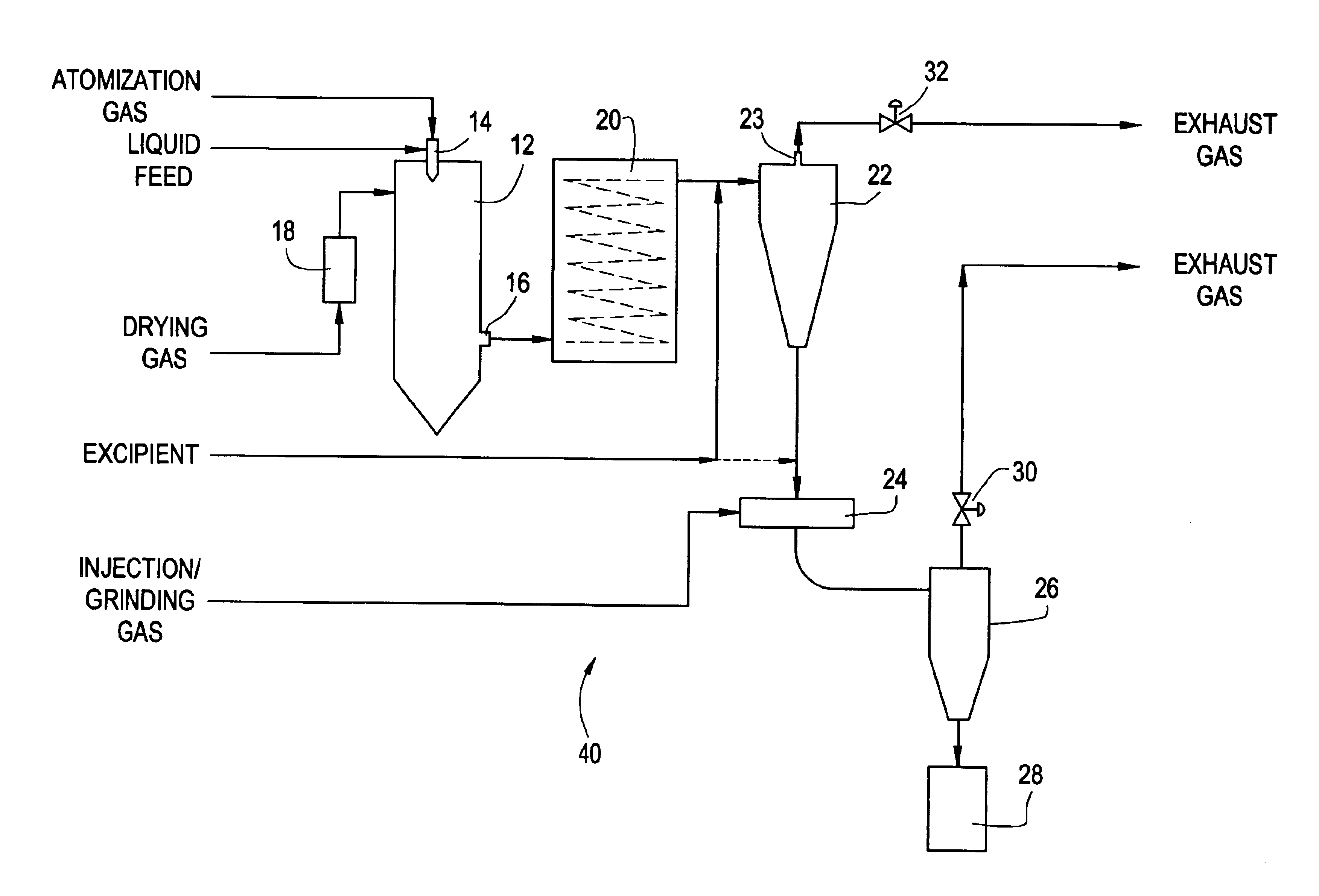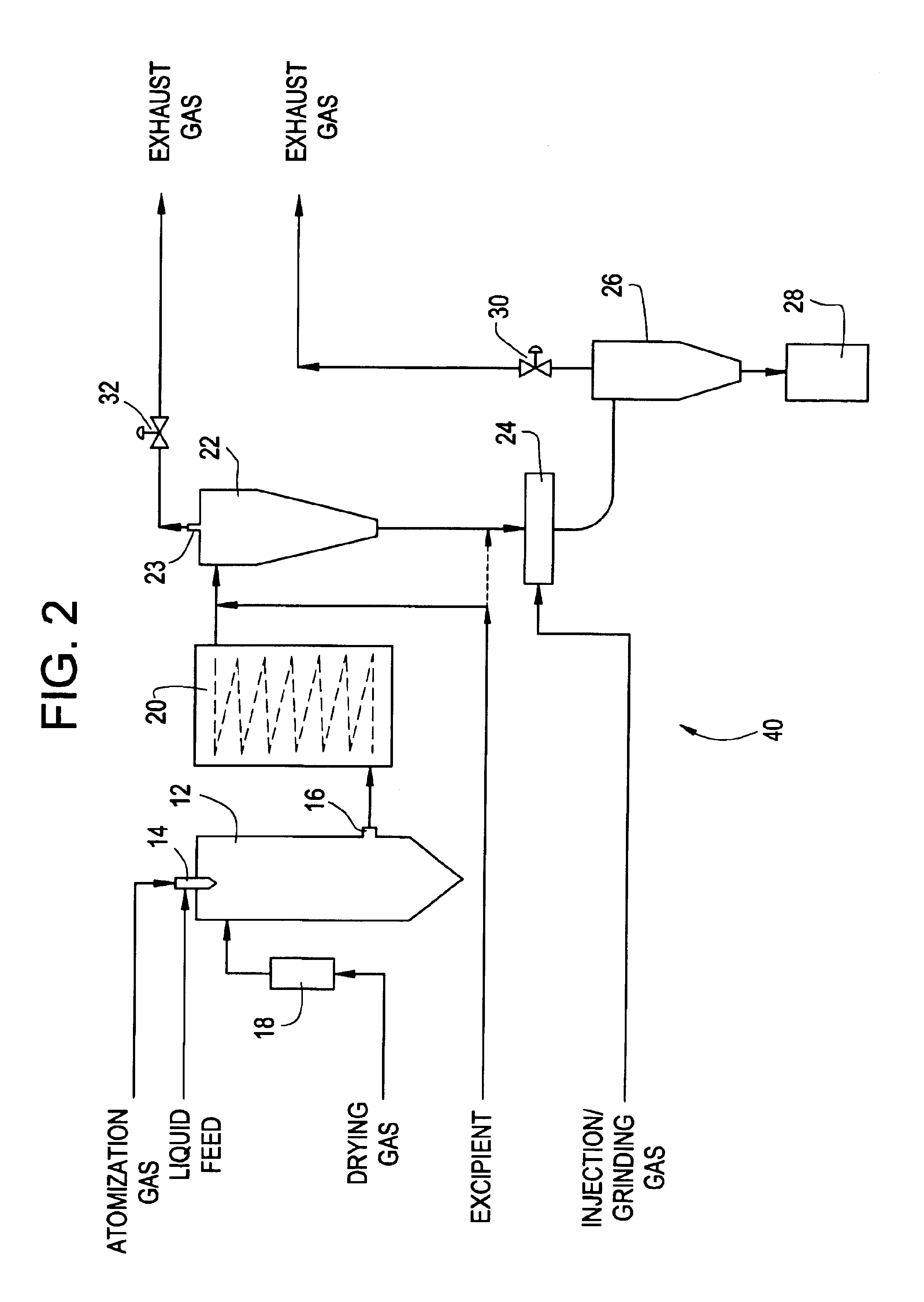Methods and apparatus for making particles using spray dryer and in-line jet mill
a technology of spray dryer and spray dryer, which is applied in the direction of lighting and heating apparatus, furnaces, separation processes, etc., can solve the problems of affecting the performance and/or reproducibility of particle formulations, affecting the effective size of particles, and affecting the performance of particle formulations. and/or reproducibility, etc., to achieve the effect of effectively cutting processing tim
- Summary
- Abstract
- Description
- Claims
- Application Information
AI Technical Summary
Benefits of technology
Problems solved by technology
Method used
Image
Examples
example 1
Spray Drying of PLGA Microspheres Without Milling (Comparative Example)
[0111]This example describes a process for making PLGA microspheres. The microspheres were made in a batch spray drying process. A polymer emulsion was prepared, composed of droplets of an aqueous phase suspended in a continuous polymer / organic solvent phase. The polymer was a commercially obtained poly(lactide-co-glycolide) (PLGA) (50:50). The organic solvent was methylene chloride. The resulting emulsion was spray dried on a custom spray dryer with a dual drying chamber set-up. The process conditions resulted in a theoretical solids to drying gas mass flow ratio of 4.77 g solids / min.: 1.6 kg nitrogen / min. The outlet temperature of the primary drying chamber was maintained at 12° C. The discharge of the primary drying chamber was connected to a custom secondary drying chamber comprising 100 feet of 1.5″Ø coiled tubing, enveloped by a water-cooled jacket. The discharge of the secondary drying chamber was connecte...
example 2
PLGA Microparticles Formed Using an In-Line Spray Drying / Jet Milling Process
[0113]PLGA microspheres were produced using a batch spray drying process with an in-line jet mill. A polymer emulsion was prepared, composed of droplets of an aqueous phase suspended in a continuous polymer / organic solvent phase. The polymer was a commercially obtained poly(lactide-co-glycolide) (PLGA) (50:50). The organic solvent was methylene chloride. The resulting emulsion was spray dried on a custom spray dryer with a dual drying chamber set-up. The process conditions resulted in a theoretical solids to drying gas mass flow ratio of 4.77 g solids / min: 1.6 kg nitrogen / min. The outlet temperature of the primary drying chamber was maintained at 12° C. The discharge of the primary drying chamber was connected to a secondary drying chamber comprising 100 feet of 1.5″Ø coiled tubing, enveloped by a water-cooled jacket. The discharge of the secondary drying chamber was connected to a concentrating cyclone havi...
example 3
Batch Processing of Celecoxib Microspheres (Comparative Example)
[0118]Celecoxib (CXB) microspheres were produced using a batch spray drying process. A solution containing CXB in 800 mL of methanol-water (65:35) was spray dried on a custom spray dryer with a single drying chamber. The process conditions resulted in a theoretical solids to drying gas mass flow ratio of 0.24 g solids / min: 1.7 kg nitrogen / min. The outlet temperature of the drying chamber was set at 20° C. The discharge of the drying chamber was connected to a cyclone collector having a 1″Ø inlet, a 1″Ø exhaust outlet, and a 1.5″Ø dust outlet.
[0119]Duplicate batches were generated. Yield was calculated as the mass of dry product divided by the dry mass of non-volatile materials in the feed stock. Geometric particle size (volume mean) was measured using an Aerosizer particle sizer set at both high shear and zero shear. Table 4 presents the yield and size results for the two batches.
[0120]
TABLE 4Yield and Particle Size Ana...
PUM
| Property | Measurement | Unit |
|---|---|---|
| vol. % | aaaaa | aaaaa |
| vol. % | aaaaa | aaaaa |
| diameter | aaaaa | aaaaa |
Abstract
Description
Claims
Application Information
 Login to View More
Login to View More - R&D
- Intellectual Property
- Life Sciences
- Materials
- Tech Scout
- Unparalleled Data Quality
- Higher Quality Content
- 60% Fewer Hallucinations
Browse by: Latest US Patents, China's latest patents, Technical Efficacy Thesaurus, Application Domain, Technology Topic, Popular Technical Reports.
© 2025 PatSnap. All rights reserved.Legal|Privacy policy|Modern Slavery Act Transparency Statement|Sitemap|About US| Contact US: help@patsnap.com



